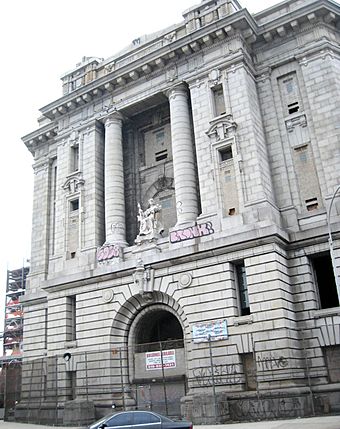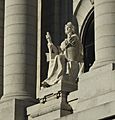Bronx Borough Courthouse facts for kids
|
Bronx Borough Courthouse
|
|

Old Bronx Borough Courthouse, December 2008
|
|
| Location | East 161st Street, Third and Brook Avenues, Morrisania, Bronx, New York |
|---|---|
| Area | 1 acre (0.40 ha) |
| Built | 1905-1914 |
| Architect | attributed to both Michael John Garvin and Oscar Florianus Bluemner; sculpture by Jules Edouard Roiné |
| Architectural style | Beaux-Arts |
| NRHP reference No. | 82003344 |
Quick facts for kids Significant dates |
|
| Added to NRHP | February 25, 1982 |
The Bronx Borough Courthouse, often called the Old Bronx Borough Courthouse, is a historic building. It is located in the Melrose area of the Bronx, New York City. This courthouse was built between 1905 and 1914. It stands near Boston Road, Third Avenue, St. Anns Avenue, and 161st Street. For about 20 years, it was home to important courts. These included the Supreme, Surrogate's, and County Courts. A larger Bronx County Courthouse was built in 1934. After that, the Bronx Branch of the New York City Criminal Court stayed here until 1977. The city then officially closed the building. Today, it is listed on the National Register of Historic Places. It is also a New York City Landmark.
Contents
Building Style
This courthouse was built in the Beaux-Arts style. This style was popular for grand public buildings. It has four stories and faces south towards Manhattan. The building is made of strong stone granite. Inside, it had beautiful stairways, fancy chandeliers, and stained glass windows.
Above the main entrance, there are two large pillars. They surround a statue of Lady Justice. Lady Justice is a symbol of fairness and protection for the law. This sculpture was made by Jules Edouard Roiné. It represents the history of the Bronx area. Two architects, Michael John Garvin and Oscar Florianus Bluemner, are credited with designing the building.
History of the Courthouse
Why it Was Built
For many years, people in the Bronx wanted their own proper courthouse. The Bronx had grown a lot since 1874. Its population increased from 40,000 to over 200,000 by 1900. Local leaders and lawyers worked hard to make this happen. Finally, the city agreed to provide money for a new building. This building would show the importance of the growing area.
In 1903, Louis F. Haffen, the first president of the Bronx, chose Michael J. Garvin to design the courthouse. Garvin was an experienced architect. He had designed other buildings in the Bronx. He left his job as Building Commissioner to focus on this important project.
Garvin's first ideas for the courthouse were not accepted. The New York Art Commission felt they were not good enough. So, Garvin looked for other architects to help him. He met Oscar Florianus Bluemner, a talented German architect. Bluemner had won awards for his designs. They decided to work together on the project. Garvin later submitted a design that the Art Commission liked.
There was some disagreement about who deserved credit for the design. Bluemner felt he was not given enough recognition. However, it was decided that Garvin had the main credit for the building. Garvin oversaw the construction from 1905 to 1914. By the time it was finished, the Bronx population was over 500,000. The building cost about $2,000,000 to build. The Bronx Borough Courthouse then opened its doors and became the center of law for 20 years.
Moving and Closing the Courts
By 1930, the Bronx population had grown even more, reaching 1.25 million people. Because of this huge growth, the city built a new, larger courthouse. The new Bronx County Courthouse was finished in 1934. Most of the court departments moved to this new, spacious building.
The old courthouse kept a police court until 1977. That year, the building was officially closed by the city. The elevated train line that ran nearby was also removed in 1973. This made it harder to get to the old courthouse. The building was used for 58 years.
During the 1970s, parts of the building's inside were damaged. People removed metalwork and broke some features. To protect the building, the city sealed all the doors and windows with concrete blocks. The building remained empty for many years.
Some city officials thought about tearing down the old courthouse. But many historians and community leaders wanted to save it. They worked to protect the building. In 1981, it was given "Landmark" status. This helped protect it for the future. However, even with landmark status, the building needed serious repairs.
New Uses for the Building
After it closed, many ideas were suggested for reusing the courthouse. People wanted to use it for community or public purposes. But fixing the historic building was very expensive and complicated.
In 1996, the building was sold at an auction. It was sold again in 1998 to Henry Weinstein, a developer. In 2011, Weinstein and his partners began to fix up the building. They cleaned the outside, which was much needed. Plans were made to improve the inside for offices, medical offices, or community facilities.
In recent years, the paintings of Oscar Bluemner have become very popular. There was even a show of his art at the Whitney Museum of American Art. However, official records still say that Michael Garvin was the main designer of the courthouse.
In 2015, an art show was held inside the old courthouse. In 2016, the building was considered as a possible home for the Universal Hip Hop Museum, but this idea was later changed. The next year, it was announced that the courthouse would become a location for a high school. This school is part of the Success Academy Charter Schools system.
Images for kids
See also
 In Spanish: Palacio de Justicia del Municipio del Bronx para niños
In Spanish: Palacio de Justicia del Municipio del Bronx para niños



